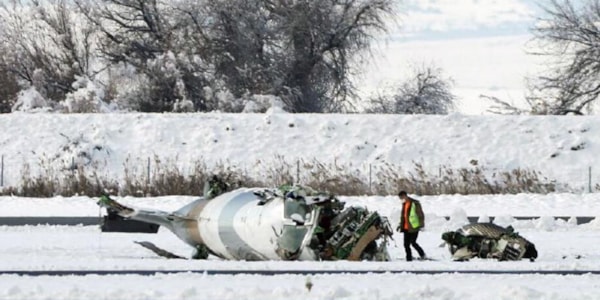Witnesses describe wintry weather, failed takeoff of Phenom 300 in deadly Utah crash

Photo from Bureau of Aircraft Accidents Archives
The NTSB released the preliminary report for the Jan. 2 Phenom 300 crash, discussing witness reports and the weather at the time of the takeoff.
Witnesses said the wings on the plane wobbled “back and forth” before the crash.
On Jan. 2, an Embraer EMB-505 Phenom 300 crashed on takeoff at the Provo Municipal Airport (PVU) in Provo, Utah.
RELATED STORY:
Phenom 300 crashes immediately after takeoff at Provo Municipal Airport
The report states that the pilot was killed, two passengers sustained serious injuries and one sustained minor injuries. The aircraft damage was substantial and the wreckage was recovered for further examination.
The plane was operated under Title 14 as a Part 91 personal flight. It was an Embraer EMB-505, N555NR that crashed after only reaching 20 to 30 feet above ground level before it struck the ground.
A witness was removing snow from the ramp area and reported that the airplane was nearby and remained hangared until 10:55. The witness watched the plane be refueled and estimated the pilot started the engines around 11:10 or 11:15, while light snow began to fall.
The plane was refueled with 350 gallons of Jet-A. The fueler stated in the report that the pilot wanted to get out before the weather, adding that while he refueled the plane he checked it over and noticed unfrozen water droplets on the wings.
The fueler returned to the FBO and observed the plane taxi past him. He said he turned to watch the takeoff, stating it began its takeoff roll on runway 13 and appeared to “pull up steep.”
He said the plane then rolled to the left causing the left wing to impact the ground. The weather at the time of the crash was snow and misty rain, between light and medium intensity with a breeze coming out of the north.
The report stated that other witnesses observed the plane ascend to roughly 20 or 30 feet and then both wings bobbed back and forth. The plane banked right and then took a hard left before the wing struck the ground. Many flights in and out of the airport were canceled and it was closed for investigation. NTSB investigators arrived on site about 23 hours after the crash, with a fresh four to six inches of snow masking the impact marks, debris and ground scars.
The site examination revealed the plane impacted the runway surface about 2,626 feet from the approach end of the runway and about 20 feet left of the runway centerline. The report said the scrape mark extended about 91 feet and was parallel to the runway centerline.
There was a second scrape mark observed about 2,903 feet from the approach end of the runway. This scrape arced left to the left edge of the runway and about 3,126 feet from the approach end. Snow and dirt extended from the left edge of the runway to about 100 feet to a big impact crater. Airplane debris and airframe components were recovered from the crater.
The wreckage debris in the crater extended about 597 feet to the fuselage. The wings had been separated from the airframe and were 106 feet from the fuselage. Both of the engines were also separated and located near the fuselage.
The airport remained closed through Jan. 4 to allow time for the investigation and the cleaning of debris.
The report was preliminary and the investigation into the cause of the crash is still ongoing.
Contact
Name: Haley Davoren
, Digital Content Manager
Company: GlobalAir.com
Website: https://globalair.com
Email: [email protected]
Phone: 502-456-3934
©2023 GlobalAir.com, Haley Davoren. All rights reserved.

Recent Comments